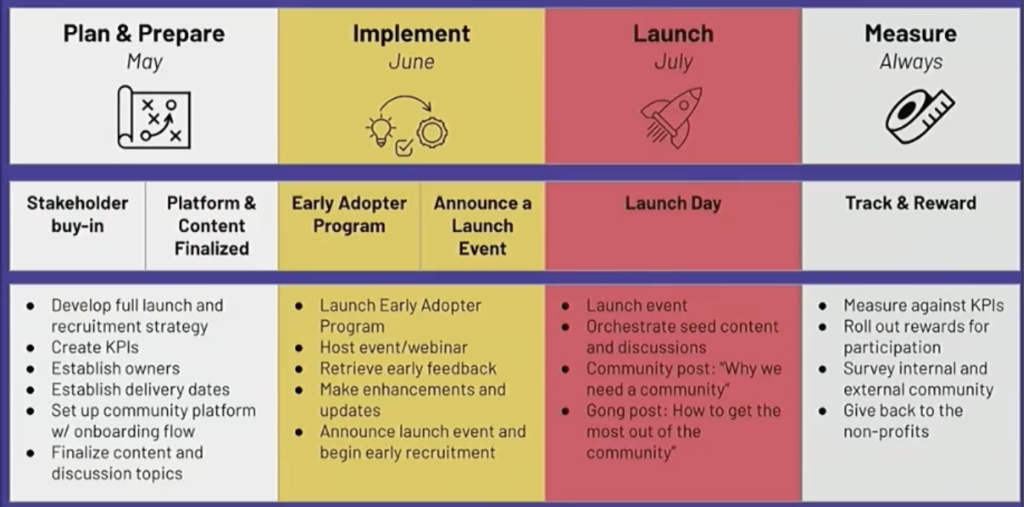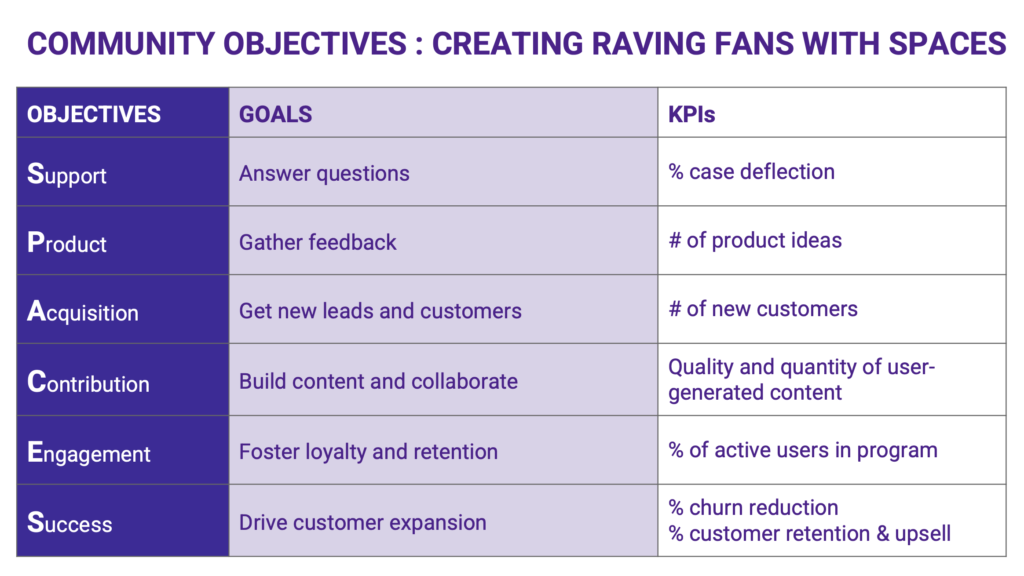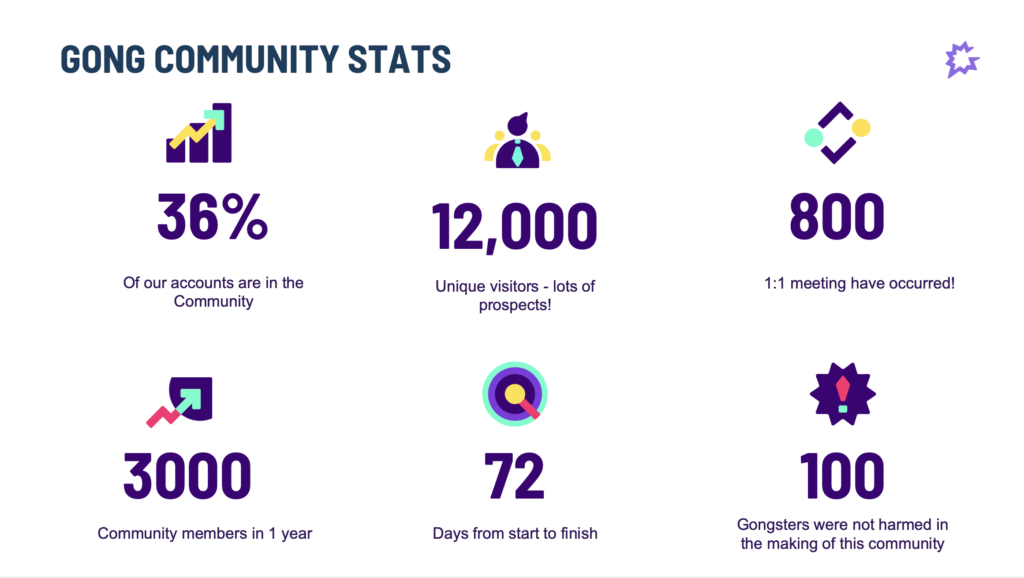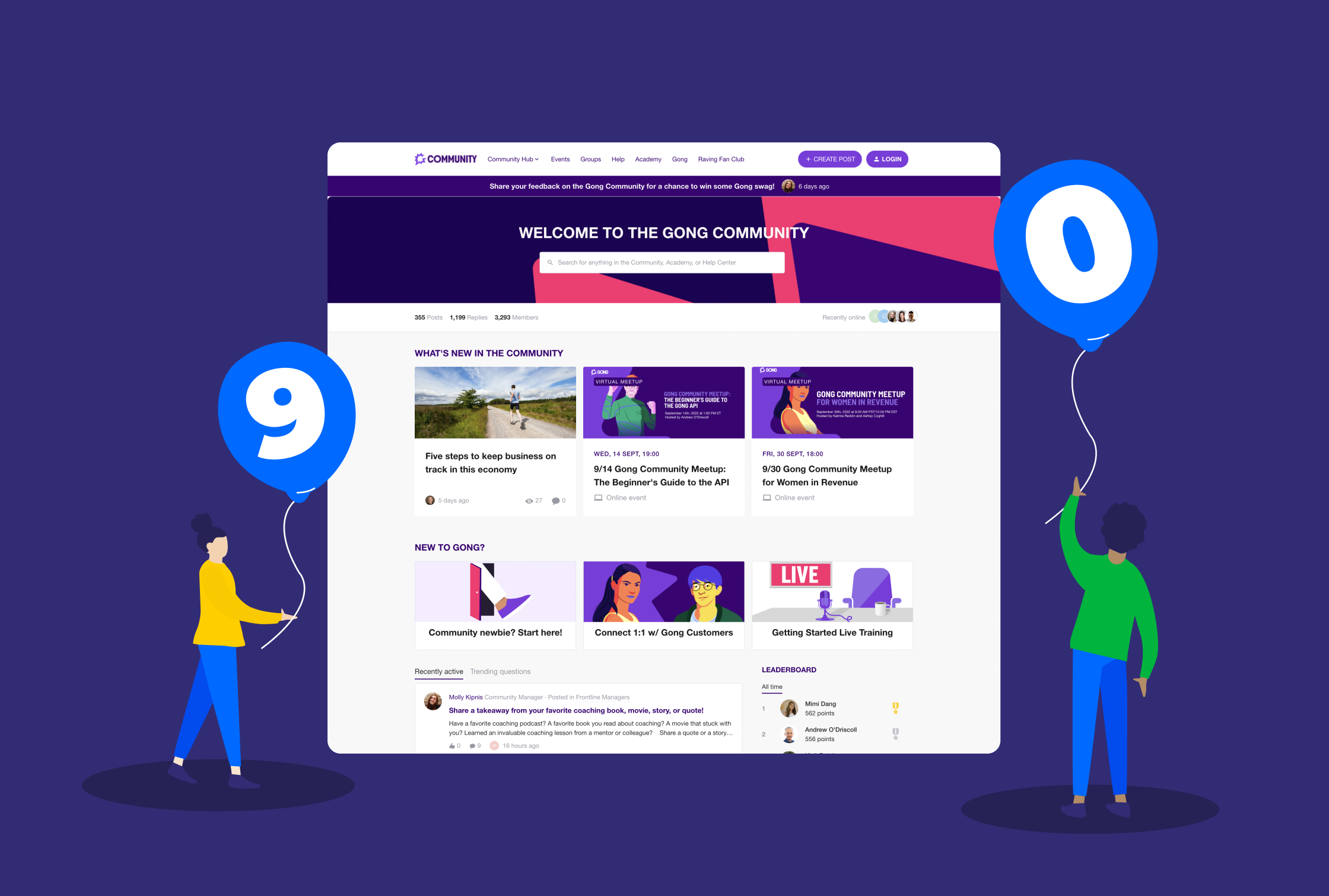A common misconception around Community is that you need a large pool of customers to start one. However, Nisha Baxi, Director of Community at Gong, argues otherwise.
During Baxi’s Pulse 2022 session, “90 Day Community: Happily Ever After the First 10 Customers,” she discusses how you can organize, plan, launch, and build your community as long as you have a community-market fit. So if you’re trying to build excitement around a new category or building excitement for customers, you should create a community (even if it’s just for 10 individuals).
Baxi says the four pillars to building a thriving community involve:
- Community success: Find Community mentors and get on calls with community managers who are doing it well.
- Internal success: Get someone on the executive level who understands the value of community and will champion it.
- Business success: Get your goals on paper and roll up your community milestones to these.
- Personal success: Get organized, block-off time, and dive in.
But how do you manage to do all these things in 90 days?
“It doesn’t have to be perfect. It just has to be done.” – Nisha Baxi, Director of Community, Gong
If you’re looking for a more detailed framework for how to launch your community, here’s how Gong accomplished it (broken down by day).

Step 0: Executive foundation
Step 0, how does that even make sense? Well, before you can even dive into the foundations of your community, you need to establish executive-level buy-in.
Make the time for discovery, discussion, logistics, and prioritization with your executive team.
Here are some of the specific actions you can take at each level:
- Discovery: Launch community discovery and see what others are doing. Get a good understanding of what the competition is doing and what can be done better or differently.
- Discussion: Get feedback from ELT on the investment.
- Logistics: Know your budget and map out how you will work with other teams.
- Prioritization: You can do many things with a community, but everyone must be aligned on which one of those goals/objectives should be tackled first.
Step 1: Community foundation (Day 1-15)
Now that you’re aligned with your executive team, you can start to build the foundation for your community, which comes from finding internal advocates. Decide what key people in Sales, Marketing, Product, Customer Success, and Support you can meet with once a week to keep them in the loop and the process. Find those who seem interested and turn them into your internal champions.
“Remember, rising tides float all boats — your community’s win will be a win for these folks.” – Nisha Baxi, Director of Community, Gong
Step 2: Discovery (Day 7-20)
You probably have a general idea of who your community is for, but you have to take it a step further and ask these personas if your community is helpful to them. Do the research and decide who your ICP is. Is it people who come to your events? People with high ARR? Who is an active customer that would enjoy being in the community?
Baxi made a list of 100+ people, brought in those internal advocates to get their opinion, and then rolled up her sleeves to call as many that would pick up. For the ones she couldn’t get in touch with, she sent a survey asking them, “what do you want to see in a community?”
She emphasizes that you must keep it open-ended and remember it should be about their wants and not yours.
Step 3: Roadshow time (Day 1-30)
Now that you have your feedback and direction, it’s time to take your community for an internal “roadshow.” Be strategic when you plan who to meet, and be sure to use your org chart.
Build a master deck, tell these individuals why you want community and how it benefits them, and get pre-alignment and pre-buy-in.
If you’re scratching your head wondering how to get those individuals with jam-packed calendars to hear your pitch? Make it simple for them and ask for a quick 10 minutes, or Baxi has even created a short video to summarize the plan for community and how it impacts them.
You want to build company-wide excitement so this step is important.
Step 4: Detailed plan (Day 15)
Now that you’ve created some buzz around the office, you need to plan. Build a detailed map of exactly how you will orchestrate the launch of your community. You may even have mini plans within each phase of your launch. Here’s how Gong broke it out.
“Plan the work, then work the plan.” – Nisha Baxi, Director of Community, Gong

Know your milestones and when it’s time to reflect on successes, and failures so you can adjust your plan as needed.
And Baxi reminds us to remember your comms and marketing plan. Why do all this hard work and not promote properly?
Step 5: Build the community!
Now it’s time to create your actual Community! InSided’s platform should provide you with the structure you need to add your content and organize it. No developer experience? No problem. We have a no-code solution so you can build a beautiful community using our customizable widgets, so you can create a beautiful community with ease.
Baxi’s community hacks for getting the work done include:
- Splitting up your day (first half of your day to meet people; the second half of your day is meant for getting the work done)
- Use the Pomodoro method (45-minute work periods)
- Community newsletter to keep people updated and in the loop
It’s just as important to keep stakeholders in the loop as you build so they can continue to stay invested in what you’re creating.
Step 6: Launch (Day 40-70)
It might be best to view your launch plan in two phases. The first phase is the soft launch, which should last about two weeks. This is meant for the first 100 people who gave feedback. Baxi called them her “community founders.” The benefit of bringing in this beta group was additional feedback, testing, and engagement for the full launch.
Phase two is the external customer launch, which should last one day before your official launch. Gong decided to announce its community at the same time as its annual event Celebrate. This exposure is responsible for one-third of its community members. So although you may need to deal with bugs on the fly, piggybacking off of an existing company event could be a strategy to consider when you launch your community.
Step 7: Measure success and recap (Day 60-72)
Once you’re done launching, make sure to pay attention to your initial impact. How many people came to launch? How many people registered? These statistics are great to gather and share internally to build up excitement. Baxi suggests creating a “by the numbers” post and share your success story.
The way Gong views success is by using a framework called SPACES. If community is done right, you should impact one or more of these objectives within this table.

“If you can’t measure it, it didn’t happen.” – Nisha Baxi, Director of Community, Gong
In Gong’s case, community stats include…

And, equally importantly, set yourself up for future measurement success by creating a dashboard so you can continuously monitor your growth and engagement.
Finally, make sure you thank everyone who made your community a success. If you followed Baxi’s advice, there are many individuals (internally and externally) who collaborated and guided you to your final destination.
Want to see more community sessions from Pulse? Check them out:
The future of customer empowerment: Community, education and predictive analytics


